Menu
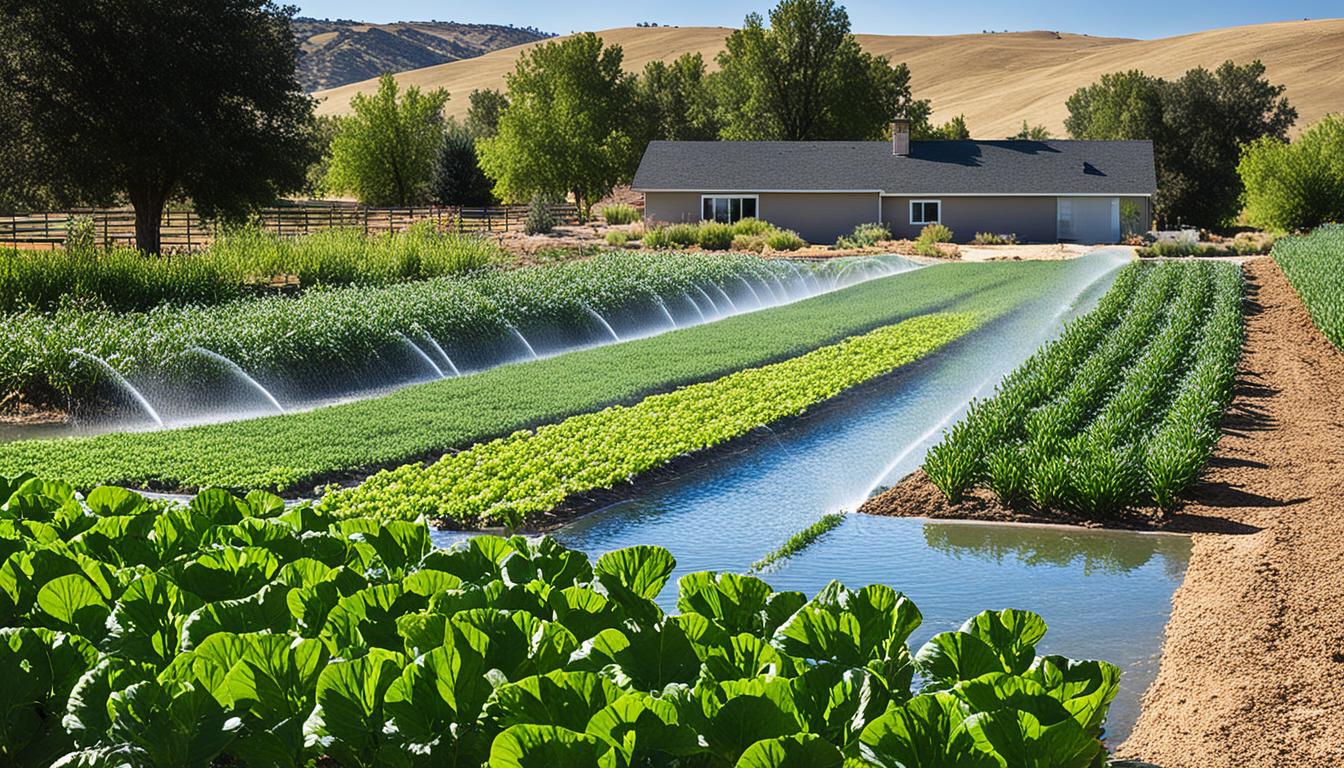
Did you know that almost 90 percent of the water supplied by the Nevada Irrigation District is used for farming? This water goes to over 5,600 places, covering more than 32,000 acres. Erika Cross from the USDA points out that just 0.5% of the Earth’s water is available. This shows how vital it is to save water in farming.
Farmers face a tough challenge with less water due to climate change. They must feed a growing population. To tackle this, techniques like drip irrigation can help. This method uses up to 80 percent less water than usual. The USDA’s NRCS is working hard to help farmers. They offer direct support. Their goal is to help farmers use water wisely.
Water is vital for growing crops and raising livestock. But, agriculture uses a lot of the world’s fresh water. This makes saving water crucial as water shortages threaten farming. By saving water, farmers help keep our fresh water resources safe for everyone. This also ensures we can continue to grow food without using up all the water.
With more people needing fresh water, saving water in farming is more important than ever. Farming methods like adding compost to the soil and using mulch can help keep water in the ground longer and stop it from evaporating. Cover crops and less soil disturbance protect the soil and use water more efficiently.
It’s also smart to catch rainwater or use treated waste water on farms. This way, farmers can make sure their crops get enough water without wasting any.
Using smart ways to water crops, like drip irrigation, helps a lot. It means less water is wasted, and plants get exactly what they need. This keeps plants healthy without using too much water. Also, growing certain crops that need less water can make farming more sustainable.
Methods like no-till farming are great for the soil and save water. They let water sink in better, rather than just running off the surface. This is another way to beat water scarcity in farming.
The NRCS supports ways to use water better on farms. From smart watering schedules to crop rotation, they help farmers grow food with less water. These methods also keep the soil healthy and reduce the risk of pests and diseases.
Farming already uses a lot of the world’s fresh water. So, using water wisely is key to making sure we have enough for the future. This is important for the planet and for feeding everyone.
Effective farm irrigation management is key to tackling water shortages across the U.S. by 2024. With 85 percent of the nation’s water used in farming, adopting innovative techniques like drip irrigation, capturing water, and planning irrigation schedules is vital. This helps make the most of water resources.
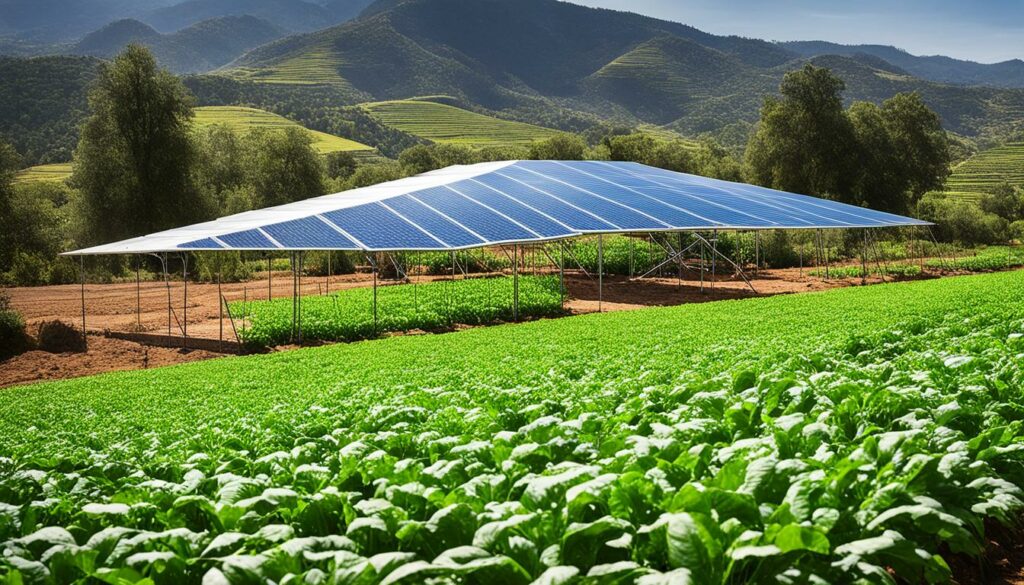
Drip irrigation is a top water-saving method in farming. It sends water right to plant roots. This cuts down hugely on water lost to evaporation and running off the fields. Farmers using drip irrigation can save up to 80 percent more water than with traditional ways. In Montana, Steve Burke cut his water usage in half using smart irrigation pipelines and sprinklers.
Storing water is crucial for managing farm irrigation. Methods like water storage ponds help keep water for use when it’s dry. This supports crop irrigation through methods like drip irrigation. It means a steady water supply, which helps crops grow better and saves water.
Having a schedule for watering is also very important. Using sensors and weather data lets farmers water their crops at the best times. This strategy saves water and makes the whole process more efficient. It helps farmers manage their irrigation better.
| Practice | Benefits |
|---|---|
| Drip Irrigation | Saves up to 80% more water, reduces evaporation |
| Capturing and Storing Water | Ensures a stable water supply, supports crop yields |
| Irrigation Scheduling | Optimises water use, minimises waste |
“By adopting advanced irrigation systems and utilising natural water reservoirs, we can significantly reduce water consumption while maintaining high productivity levels.”
Using water wisely in farming matters a lot because most of the world’s fresh water goes to making food and materials. Flood irrigation is common, covering about 600 million acres. But, this method uses a lot of water. It’s time to change how we water our crops to save water. Newer ways, like micro-irrigation, use less water. For crops like corn and cotton, they can cut water use by half.
In the U.S., more than 20 million acres are still flood irrigated. But we can do better. Technologies like centre pivot irrigation offer a path to saving water. Centre pivots are mainly used in the U.S., but they’re not common worldwide. Drip irrigation is another smart choice. It’s used on a small part of the world’s farms, but it can save a lot of water.
Using real-time data in farming makes watering crops very exact. This uses water better and helps crops grow well. In the 2023 Colorado TAPS program, teams showed how effective this approach is. The best teams at growing crops used the least water, proving they’re really smart at managing resources.
“The most profitable contestant was also the contestant that had the most input-use efficient farms,” a notable observation from the 2023 Colorado TAPS program, demonstrating that economically viable practices are often synonymous with sustainable ones.
To sum up, it’s clear:
Following these smart irrigation tips can help farmers use less water while growing more. It’s about making farming better for the future.
Improving soil health is key for keeping water in the ground. This is vital as the world faces issues from climate change. Farmers can make soil hold more water by using compost and mulch. These are green ways to take care of the soil and keep water in.
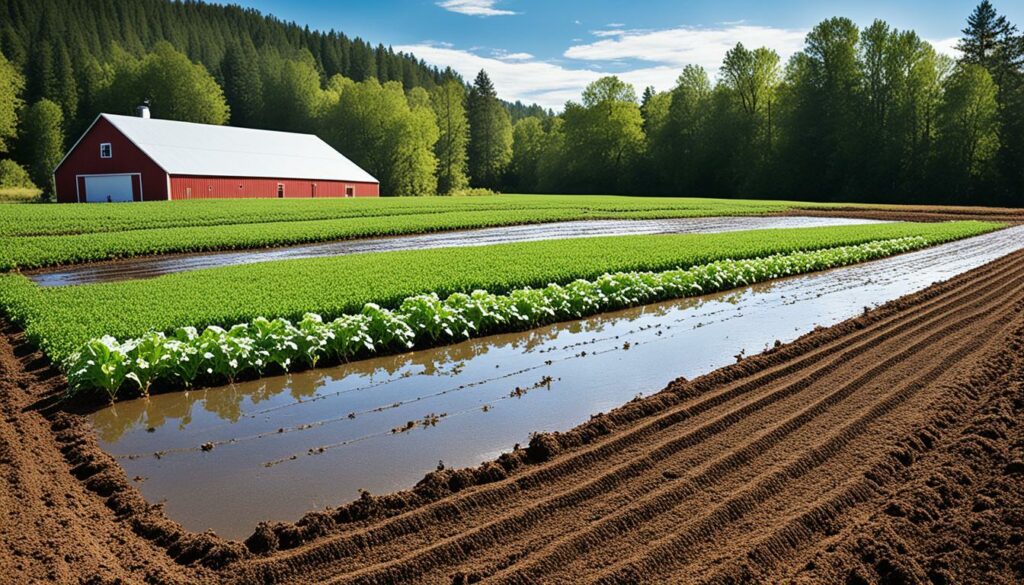
Adding compost and mulch is a great way to save water in the soil. Compost makes soil better at holding water and being healthy. Mulch stops water from disappearing and keeps the ground cool.
Plus, they stop soil from washing away and prevent weeds. This makes them a must for farmers who care about the environment.
Increasing the organic matter in the soil by just 1% through adding compost can help save a lot of water. In California, using these methods on all farming land could mean needing less water to grow crops.
Dry farming uses only the rain that falls naturally. It’s really important in places where water is very scarce. Farmers who dry farm prepare the land in special ways to keep as much water as they can.
They don’t plough the land much or at all. This helps save water and makes the soil hold onto more of it. It’s a way of farming that doesn’t need a lot of new water added.
In the Northwest part of the US, farming with less tilling has made a big difference. It has made the soil better and able to keep more water. This way encourages strong plant roots that help the soil stay moist.
The following table shows how different ways of taking care of the soil help keep water where it’s needed:
| Technique | Benefit | Statistics |
|---|---|---|
| Compost Application | Improves soil structure and fertility | 1% increase in soil organic matter can store 20,000 gallons of water per acre |
| Mulching | Reduces evaporation and maintains cooler soil temperatures | Helps reduce irrigation demand by over 208,000 acre-feet per year |
| Dry Farming | Relies on natural rainfall, minimizing water input | Effective in arid climates |
| Conservation Tillage | Enhances soil quality and water retention | Improves soil water storage capacity significantly |
Drip irrigation systems are known for saving water and keeping crops well hydrated. They save a lot more water than traditional methods. Drip irrigation uses water 90% better than sprinklers do, making farming more sustainable.
This method has many benefits. It reduces water loss through evaporation and runoff, improving the growth of plants. By watering the roots directly, plants get just the right amount of moisture. This also reduces weed growth and lowers the risk of diseases because the leaves stay dry.
Knowing the parts of a drip system is key to using it well. These include a mainline, valves, and filters. It’s important these parts are not too far apart for the system to work well. Filters should have a fine mesh to stop clogging.
The way the system is laid out matters too. Drip tubing and emitters should not be too far from the water source. This is to make sure water reaches all plants equally. Cleaning and checking parts regularly keeps the system running smoothly.
A drip system typically runs every day, pausing only if it rains. The best time to water is in the morning to reduce water loss. Watering in the evening might make plants more prone to diseases. Managing the system effectively saves water and helps plants stay healthy.
While setting up a drip system can cost more at first, it’s worth it. The system can boost crop yield and save lots of water. It’s particularly good for crops like bananas and grapes, saving water by 40-68% and increasing yield by 23-152%.
To sum up, drip irrigation is a smart and green way to farm. It cuts down on water use, improves crop growth, and makes agriculture more efficient. It’s good for the planet and your harvest.
Cover crops are key in sustainable farming, keeping soil moist. They include plants like legumes and grasses. These crops help soil stay cool, prevent erosion, and cut down on water loss. They boost the soil’s organic matter, improving its ability to hold and use water.

Studies show the benefits of these crops. UC Davis found improved soil health and water storage on ten farms in California. In Iowa, using cover crops with corn and soybeans cut down on nitrogen and phosphorus loss. This helped protect water quality.
Worldwide research highlights the positive influence of cover crops on storing water. These crops help soil absorb water and prevent it from evaporating or running off. This is crucial for keeping soil damp without affecting crop yields. In Iowa, using cover crops did not decrease corn production or water use.
Programmes like the USDA’s EQIP and the CDFA Healthy Soils Program help farmers afford cover crops. While it may cost around $25 to $30 per acre to use, the benefits are worth it. These include less erosion, healthier soil, and better water management.
Cover crops are also good for the environment. They attract helpful insects and wildlife, keeping ecosystems in balance. They provide food for animals and help prevent diseases in crops.
Choosing the right cover crop is crucial. Farmers need to pick plants that match their climate. They also need to plant and remove them at the best times. Doing this can lead to strong, sustainable farming.
No-till farming is at the heart of sustainable farming methods. It avoids disturbing the soil and keeps a lot of leftover plant material on top of it. This helps the land hold more water, making it better for plants and requiring less man-made watering. Plus, it improves how water soaks into the earth and stays there, all while cutting down on soil loss.
The main no-till farming benefits are less energy use and more efficient water absorption. It uses around 25% less energy than traditional farming. Research shows that no-till fields soaked up water nearly ten times faster than tilled ones. This is a key discovery because it shows how no-till methods are not only eco-friendly but also more effective than the old ways.
To hold onto water, it’s important to keep at least 60% of the ground covered with leftover plant bits. These cover crops are crucial for saving water that plants can use. They also keep moisture in the soil by catching snow on the surface. It’s vital to make sure the soil is not deeply disturbed to stop the loss of plant food and to keep the soil healthy.
When it comes to farm irrigation management without tilling, a ‘one size fits all’ approach doesn’t work. It’s key to tweak methods to suit the crops and the land. Here are some pointers:
Strategies like these highlight the value of sustainable agriculture practices. They help keep the soil fertile and save water. No-till farming benefits reach far, ensuring modern farming is both eco-friendly and cost-effective. This is why many farmers are choosing no-till as their main method.
| Parameter | No-Till | Tilled |
|---|---|---|
| Energy Use Reduction | 25% | Baseline |
| Residue Cover | 60% Minimum | Variable |
| Infiltration Rate | 4 inches/hr | 0.4 inches/hr |
| Soil Moisture Loss | 1/2 to 3/4 inch/trip reduction | Higher with each tillage trip |
Farming uses 85% of the U.S. water supply, making water conservation very important. By using sustainable agriculture practices such as conservation tillage and cover cropping, we can save a lot of water. Drip irrigation, though a bit expensive upfront, saves up to 80% more water than usual. This is vital because most of the water from places like the Nevada Irrigation District goes to farms.
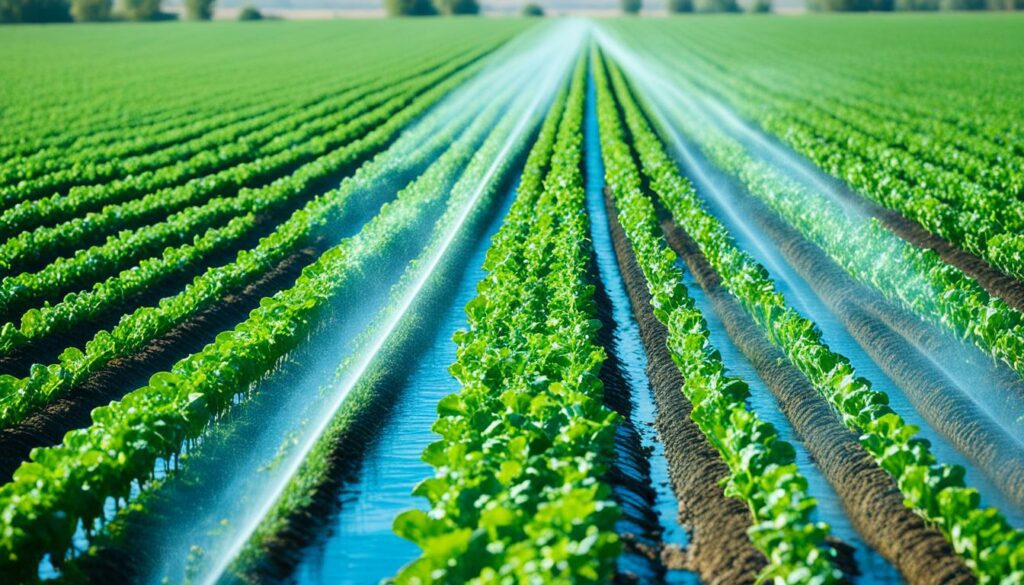
A good way to save water in farming is to take care of soil and plants better. Doing things like rotating crops and using plants that need less water help a lot. Rotational grazing is another smart choice as it boosts water absorption in soil, makes grasslands more resilient in dry times, and cuts down on water runoff. This shows how including animals in farming can help with water saving.
Putting water on crops the smart way can really cut down waste. Using sprinklers that aim the water only where it’s needed, along with sensors that check how wet the soil is, is very effective. Conservation tillage also does a great job by making the soil hold more water, needing less irrigation.
| Water Conservation Practice | Benefits | Implementation |
|---|---|---|
| Drip Irrigation Systems | Saves up to 80% of water | Use in crop-specific fields |
| Conservation Tillage | Reduces soil erosion & increases water absorption | Minimises tilling post-harvest |
| Rotational Grazing | Enhances pasture resilience & decreases runoff | Rotate livestock to prevent overgrazing |
| Cover Cropping | Maintains soil moisture & reduces evaporation | Plant legumes or grasses during off-season |
| Crop Rotation | Reduces water demand & improves soil health | Alternate between deep and shallow-rooted crops |
With 40 U.S. states possibly not having enough water by 2024, we must start using sustainable agriculture practices more. These methods not only save water but also help farming keep going strong.
Using crops that can survive with little water helps save water. Farming, in the U.S., uses most of the available water. Selecting the right crops is vital as water shortages are expected to grow. By 2024, around 40 states may face water scarcity.
Choosing plants that naturally need less water is smart. They keep producing even without lots of water. This supports efforts for farming that’s kind to the environment.
To pick the right drought-resistant crops, you need to know about the climate and soil. Maize and rice are good choices for saving water. Plants that are local to the area often do well without much water, too.
Some plants do great in dry areas, helping with sustainable farming. Pearl millet is an example, as it does well in places that don’t get much rain. Olives, potatoes, and apple trees are efficient with water, too.
Native Seeds/SEARCH shows that using old corn and wheat types can cut water use by half. This proves that traditional crops can help in modern times.
Farming with these special plants helps save water. It makes food production more sustainable despite the changing climate.
| Crop | Water Efficiency | Benefits |
|---|---|---|
| Pearl Millet | High | Thrives in dry conditions |
| Chapalote Corn | High | Reduces water usage by up to 50% |
| Olives | Moderate | Requires minimal irrigation |
| Apple Trees | Moderate | Suitable for dry farming |
Using crops that need less water is important for the environment. These plants are key for sustainable farming and water saving. They play a big role in making agriculture more adaptable to a changing climate.
Using water-saving tech in farming is key for better sustainability. Advanced irrigation systems and soil moisture sensors help conserve water. This is vital for supporting eco-friendly farming.
Advanced irrigation systems, like drip ones, are great for saving water. They send water right to plant roots. This cuts down on water loss from evaporation and runoff. They use 30-70% less water than classic methods.
Micro-sprinkler systems are also efficient, reducing water use by 20-50% versus normal sprinklers. They make sure water gets to plants evenly. This helps save water.
Soil moisture sensors play a big role in saving water in farming. They give real-time data on how wet the soil is. This helps farmers know when to water, cutting water use by 20-30%.
Adding these sensors to advanced irrigation makes farming more water-wise. It’s a smart, data-driven method for using water better.
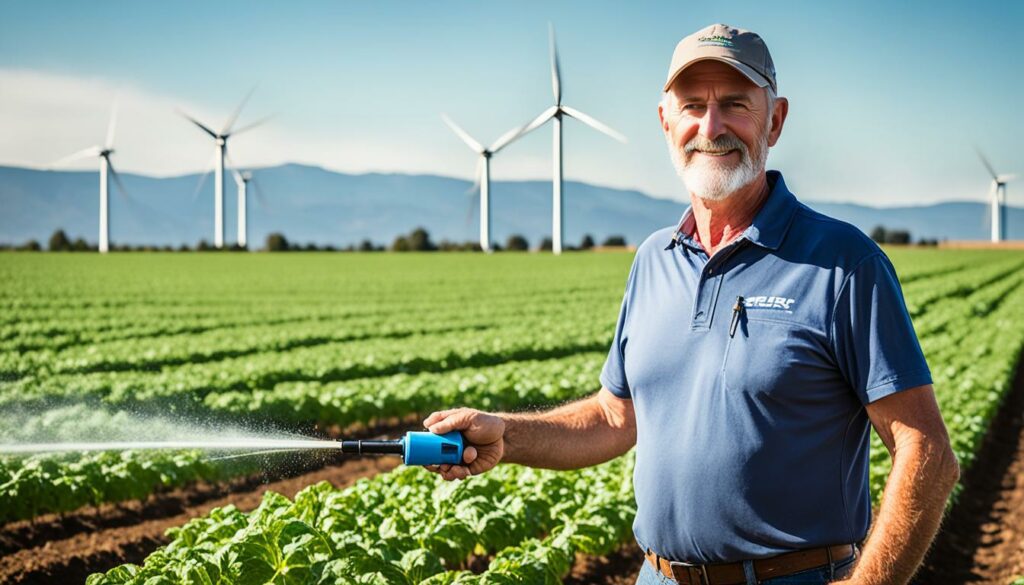
| Technology | Water Savings |
|---|---|
| Drip Irrigation Systems | 30-70% |
| Micro-Sprinkler Systems | 20-50% |
| Soil Moisture Sensors | 20-30% |
Turning to these water-saving tools in farming is wise and needed. It makes farms more sustainable and saves money. By using advanced irrigation and sensors, we protect resources. This is good for the planet and for business.
Conservation tillage is key in improving water use on farms. This method involves leaving 30% or more of the soil covered. It helps reduce soil erosion and water loss, which is good for the land’s future.
Conservation tillage is great at lowering soil erosion. For example, fields with no-till farming saw a 99% decrease in surface runoff on slopes. Strip-tillage in the southeastern area also reduced surface runoff by 55%. These methods protect soil and help it hold more water for crops.
Conservation tillage boosts the soil’s water holding ability. It does this by leaving plant residues on the ground. These residues lower the amount of water lost to evaporation. This way, there’s more water for crops. Winter cover crops, for example, add a lot of residue. This means more water soaks into the ground and less runs off.
Now, let’s look at some data comparing conservation tillage on different soil types:
| Soil Type | Runoff Reduction with No-Till | Average Runoff Compared to Conventional Tillage |
|---|---|---|
| Group B | 56% | Lower |
| Group C | 85% | 67% of Conventional Tillage |
| Group D | 9% | No Difference |
These figures show how important conservation tillage is for sustainable farming. It helps save water, making crops healthier. Such farming methods are crucial for the sustainable use of water in agriculture.
Crop rotation is key for better soil and water use. Alternating crops boosts what the land can produce. This method enriches the soil, helps it keep nutrients better, and uses less water. It also means using plants that need different amounts of water, saving water overall.
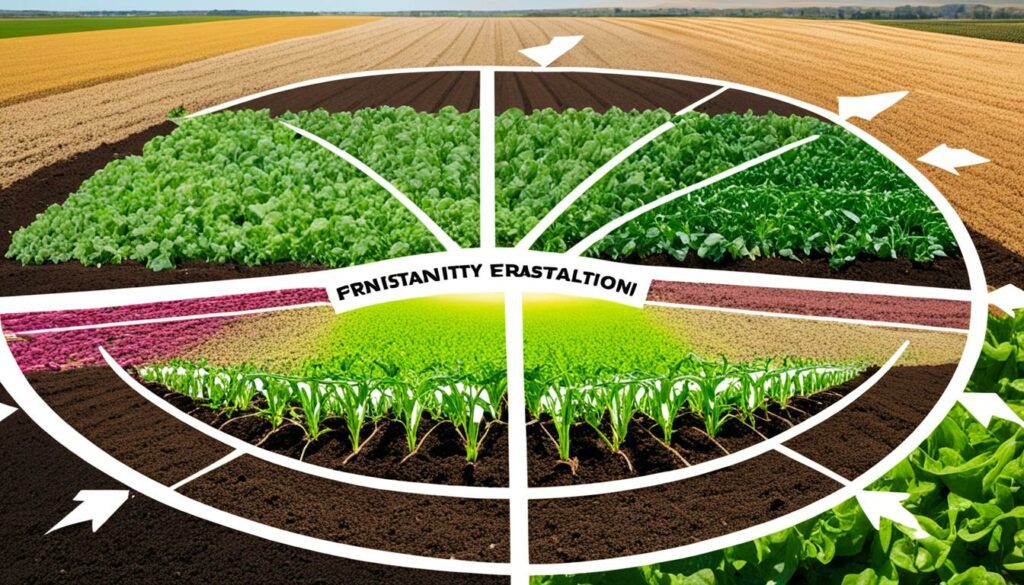
Crop rotation also makes soil better at soaking up and keeping water. With a mix of crops, there’s more organic matter in the soil. This makes it hold water well, needing less irrigation. It reduces soil erosion, keeps pests in check, and helps farming last long. Plus, it boosts harvests and fights back against droughts.
Planning how to switch crops can really help save water. This means less soil damage and more resilience against dry spells. Mixing deep and shallow roots uses water smartly all year. It also helps keep the land in balance, supporting long-lasting farming.
Good farm irrigation management is key to using water well and making farming sustainable. It’s vital to watch and change how we water our fields based on the weather and what our crops need. This way, we make the best use of water.
To save water, we must check our irrigation systems often. Soil moisture devices show us exactly how much water our plants need. We should water our crops when the weather is cooler to avoid losing water to heat and wind.
Fixing leaks stops water from being wasted. This makes our whole system work better.
Products like Verdesian’s Safe Zone™ and Aqua-Pam™ help water soak into the soil better. This keeps more water available for plants, reducing the stress on them. Drip irrigation can save up to 80% water, making farming more sustainable.
Using these solutions together can make our watering plans much better. They help us use water wisely. By being smart and using the right tools, we can grow food without wasting water. This is important for the future when water may be scarce.
| Strategy | Description | Expected Benefits |
|---|---|---|
| Soil Moisture Monitoring | Using devices to ascertain precise irrigation needs. | Improves efficient water usage and crop health. |
| Repairing Leaks | Identifying and fixing leaks within the irrigation system. | Prevents water loss, enhancing system efficiency. |
| Verdesian Products | Utilising Safe Zone™ and Aqua-Pam™ to boost water retention. | Increases moisture availability and reduces water stress. |
| Drip Irrigation | Installing systems that provide water directly to roots. | Saves up to 80% of water compared to conventional methods. |
| Climate-adjusted Scheduling | Avoiding irrigation during adverse climatic conditions. | Conserves water and prevents over-irrigation. |
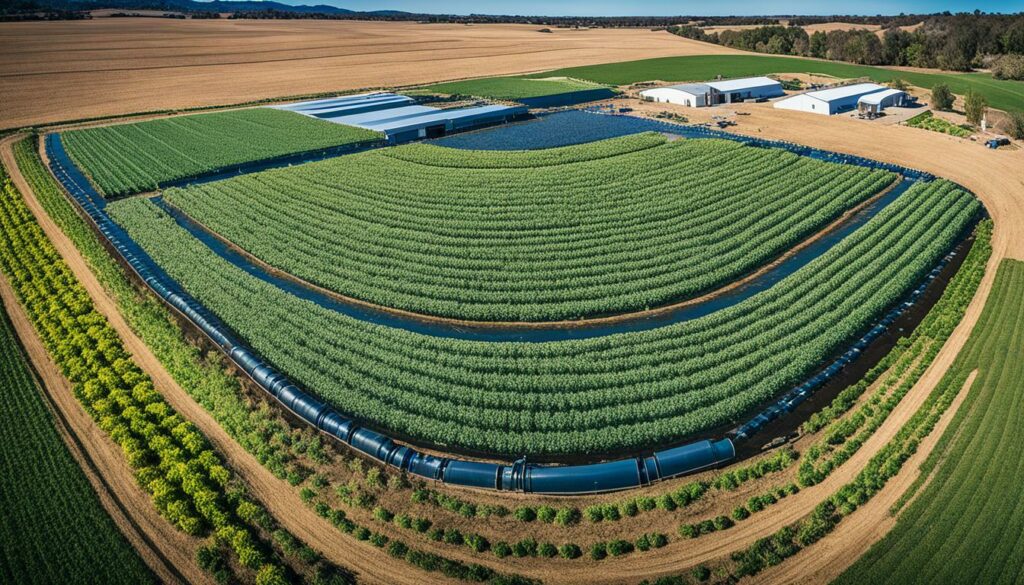
In today’s world, using eco-friendly farming techniques is vital for our water. This includes things like controlling pests naturally and using only organic fertilisers. These methods help save water and benefit both the planet and farmers.
Biological pest control is a key part of eco-friendly farming. Farmers avoid using chemicals by letting natural enemies and friendly bugs control pests. This keeps the soil healthy. Healthy soil keeps more water and means crops need less water. Water is saved, helping our environment and our farms.
Using organic fertilisation is also crucial. It means adding compost and natural fertilisers to the soil. This makes the soil better at holding water. So, farmers need to water their crops less. Organic fertilisation helps farmers produce more and keeps the land healthy for longer.
These green farming ways show how we can farm for the future. In Nevada’s irrigation district alone, 90 percent of water is used on farms. Using methods like pest control and organic fertilisation here is very important.
By using these methods, farmers can make sure they use water wisely. This is big because farming uses 85 percent of water in the U.S. Changing how we farm can help a lot in saving water. This means a better tomorrow for everyone.
Saving water in farming is now more important than ever. With the world’s population growing, many will face serious water shortages by 2030. It’s crucial to start using water-saving methods in agriculture now. Techniques like AWD irrigation and drip systems are great ways to use water more efficiently. They can save a lot of water while still growing crops well.
Using sensors to check soil moisture helps to water plants only when they really need it. This stops plants from getting too much water, which is a waste. Collecting rainwater to use for irrigation is another smart move. It lessens the need for fresh water. Agricultural practices that include using the latest sprinkler systems also help save water by being more precise.
Picking crops that don’t need a lot of water is smart. Farming uses more water than any other industry, especially in the U.S. With the right tools, farmers can use just enough water. This not only helps the environment but also makes sure there’s enough food and money for everyone. It shows how saving water and doing well economically go hand in hand.
The future of farming lies in being smarter with water, reusing water, and growing food indoors. These new approaches will make farming better for the planet. By following these tips and farming in a sustainable way, we can have a greener future. It’s up to all of us to use water wisely and succeed in sustainable farming.
Sustainable farming methods focus on using water wisely. This includes drip irrigation, which sends water straight to plant roots. It also involves keeping the soil damp, planting cover crops, and avoiding ploughing. These techniques save water and stop it being wasted.
To lessen water concerns, we can use water in smart ways. This means using tools and tech to water crops only when they really need it. It includes using gadgets like soil moisture sensors to find out how wet the ground is. The aim is to use water carefully and protect the earth’s water reserves.
Producing food the right way needs smart choices. Better water use, growing plants that don’t need a lot of water, and eco-friendly farming methods are key. These methods help keep the land and water healthy, and can grow food for the long term.
Drip irrigation is a smart way to water plants. It sends water just where the plant can use it. This means less water is lost to the air or the ground. It works well for many kinds of plants and soil types, and can help increase how much food is grown from one area.
Having ponds, tanks, and other places to save rainwater is smart. These help farms have water even when it’s dry. It cuts down on how water is used, helps plants keep growing, and makes sure there’s always enough water around.
Knowing when to water is vital for farm crops. Using weather info and sensors, farmers can decide the best time for each crop. This keeps water use under control and helps crops grow strong.
Compost and mulch make the soil better. They add good stuff to the dirt and stop water from disappearing too fast. They also keep weeds away. All this helps plants grow better and the land stay healthy.
Dry farming is growing plants with little extra water. It can work in places that don’t get much rain. By using the water that’s naturally there, it makes the most of what the land can do alone.
Cover crops protect the soil and add good things to it. They stop water from vanishing fast and make the soil better at holding water. This means more water for plants to use.
No-till farming keeps the earth’s skin undisturbed. This makes it soak up and keep water better. It also helps plants get to the water stored in the ground. As a result, it uses less water all around.
Picking plants that can do with less water is a good move. It means you don’t have to water as much. These plants use water in a clever way, making sure there’s enough to go around.
New ways to water plants cut down on waste. They make sure each drop goes right to where it’s needed. This saves water and helps plants grow as well as they can.
Not digging up the soil too much helps in many ways. It stops water from running off, keeps the ground moist, and makes sure water stays where plants can reach it. This way, it’s easier to grow crops with less extra water.
Changing which crops are planted helps the soil soak up water. It also mixes things up underground in a good way. This makes sure plants don’t all use water the same, saving water in the end.
Keeping a close eye on how crops are watered is important. It’s about using what we know to water plants just the right amount. This saves water and keeps the farm running well.
Focusing on the earth and not using chemicals too much helps the soil be its best. It means water goes straight to helping plants. These ways help use water in the best way without harming the land.